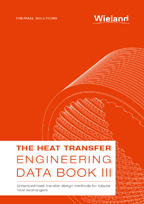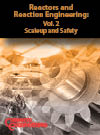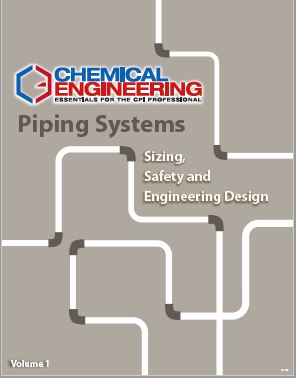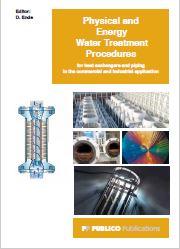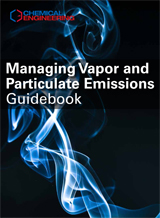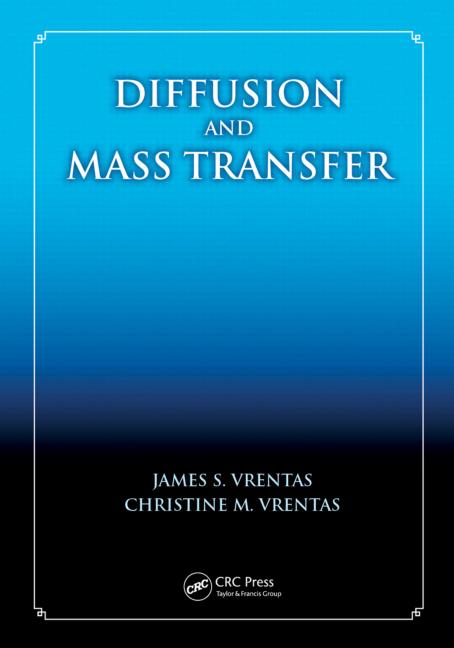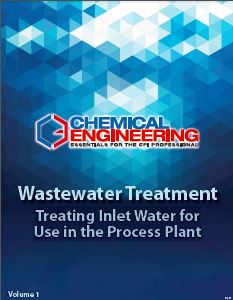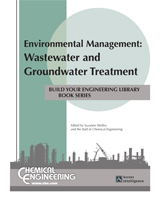
CHAPTERS: Chapter 1.Treatment technologies; Chapter 2. Managing odor and emissions; Chapter 3. Groundwater and soil remediation, Chapter 4. Pipeline issues; Chapter 5. Emissions monitoring; Chapter 6. Data and calculations; Chapter 7. Safety issues; Chapter 8. Treating inlet or process water; Chapter 9. Related topics
CHAPTER 1. TREATMENT TECHNOLOGIES
Combination therapy tackles wastewater toxins
Manfred Morper, Linde AG
Treating wastewater: Combine membranes with mechanical vapor recompression
Raynald Labrecque and Normand Bedard, Institut de Recherche d’Hydro-Quebec
High-shear membrane separation for process & wastewater treatment
Brett Elias and Jabez Van Cleef, Komline-Sanderson
For water treatment, consider high-pH reverse osmosis
Khaled Moftah, Consultant
Improving wastewater pH control
Anthony Sobkowicz, Engineering Resource, Inc.
Bioaugmentation: Put microbes to work
Christopher M. Huban, BetzDearborn, Inc., and Robert D. Plowman, Sybron Chemicals, Inc.
Oxygen-based options for purifying wastewater
Joachim Hertramf, Messer Group , Abdol Hossein Shadiakhy, Wedeco Ozontecknik
Aerobic versus anaerobic wastewater treatment
Dwight Robinson, James White, Alan Callier, Burns & McDonnell Engineering Co.
Treating industrial wastewater: Anaerobic digestion comes of age
Robbert Kleerebezem, Technical University of Delft, and Herve Macarie, Institute de Recherche pour le Developpement
Put the breaks onwastewater emulsions
George Alther, Biomin, Inc.
Scaleup of agitated thin-film agitators
William B. Glover, LCI Corp.
CHAPTER 2. MANAGING ODOR AND EMISSIONS
Controlling VOC emissions during wastewater treatment – Part 1
William Beck, Trinity Consultants , Michael Henry and Victor Edwards, Kvaerner Engineering and Constructors
VOC-control options during wastewater treatment – Part 2
Victor Edwards, Kvaerner Engineers & Constructors
For wastewater odors, dilution may be the best solution
Paul Tetley, Strobic Air Corp.
Odor prevention and control in process plants
Terry Robbins and Roy Manley, BetzDearborn
Exploring VOC control options
Jeffrey H. Siegell, Exxon Research and Engineering Co.
Abating halogenated VOCs
Robert Keller and James Dyer, DuPont Co.
Controlling H2S emissions
Gary Nagl, U.S. Filter Corp.
Removing H2S from gas streams
Gary Nagl, USFilter Gas Technology Products
Selecting the solvent for SO2 removal by absorption
Soumitro Nagpal and P.K. Sen, Engineers India Ltd.
Taking stock of activated carbon’s many talents
Stephanie Carr and Robert Vaughn, Calgon Carbon
Prevent thermal runaways in carbon beds
Thomas Hofelich, Marabeth LaBarge and Denise Drott, Dow Chemical Co.
CHAPTER 3. GROUNDWATER AND SOIL REMEDIATION
Groundwater cleanup options
Diane S. Roote, Ralinda R. Miller, Jeffrey A. Sacre, and A. Thomas Merski, Groundwater Remediation Technologies Analysis Center
Tackling tough groundwater contaminants
Doug Beal and Harlan Faircloth, BEM Systems, Inc.
Coping with groundwater contamination
Mark Maimone, Camp Dresser & McKee
Surfactants tackle surface pollutants
Laura Yeh, Naval Facilities Engineering Service Center, Dick Jackson, Duke Engineering & Services
Contain contaminated groundwater
Robert D. Mutch, Jr., Robert E. Ash IV, Jeffrey R. Caputi, Eckenfelder, Inc.
Stripping organics from groundwater and wastewater
Bruce Lamarre and Don Shearhouse, North East Environmental Products, Inc.
Use air sparging and vapor extraction to remediate subsurface organics
M.C. Marley and E.X. Droste, Envirogen, Inc., H.H. Hopkins, American Petroleum Institute, C.J. Bruell, University of Massachusetts
Control fouling in groundwater pump-and-treat systems
John Dilzell, BetzDearborn Water Management Group
Minimize scale formation during groundwater treatment
Robert DeGiorgio, Lawler, Matusky and Skelley Engineers LLP
Soil contamination: Dealing with petroleum spills
Sofia Stokman, Consultant, and Brian J. Sogorka, N.J. Dept. of Environmental Protection
A geochemical way to keep metals at bay
Jim V. Rouse, Maureen C. Leahy and Richard A. Brown, Fluor Daniel GTI
Design tips for precipitating metals
Richard Rast, Talisman Partners, Ltd.
Remediating organic-laden soils: Do your homework before breaking ground
Thomas McGowan, TMTS Associates, Inc.
Using chemical screening during site remediation
Lawrence Kahrs, Lewis Horzempa, David Peterson, Foster Wheeler Environmental Corp.
CHAPTER 4. PIPELINE ISSUES
Working the kinks out of piping design
Fred Bandel and Jeff Lawson, ProcessPlus
Approximating equations for pipe sizing
B.B. Gulyani, University of Roorkee
Select the optimum pipe size
Ronald W. Capps, Gulf Coast Consulting Group
Updated rules for pipe sizing
Alejandro Anaya Durand, Jorge Arroyo Boy, Joaquin Lastra Corral, Luis Ojeda Berra, Jose Suarez Trueba, Petro Villalon Brena, UNAM
Pipe design for robust systems
Michael Bussler, Algor, Inc. , and Tony Paulin, Paulin Research Group
Correlate pressure drops through fittings – Part 1
Ron Darby, Texas A&M Univ.
Correlate pressure drops through fittings – Part 2
Ron Darby, Texas A&M Univ.
Save pipes from bursting with a compensator
Jack Boteler, Flowguard USA , and David Clucas, Flowguard Ltd.
The use of certified KR for rupture disks
Jeff Scoville, Oseco
Calculate pipeline flow of compressible fluids
T.W. Cochran, BASF Corp.
Keeping pipelines safe from harm
Brian Payne, EDM Services
Improving pipeline safety
Brian Payne, EDM Services
Selecting secondary containment piping
Anthony Palozzolo, Perma-Pipe, Inc.
Picking the best thermoplastic lining
Gary Dennis, Elf Atochem North America, Inc.
The case for flangeless plastic-lined pipe
John M. Kalnins, Dow Chemical Co. , and Nancy L. Lindley, Unistrut Corp.
Keep piping insulation dry
Brent Cottingham, Refrigeration Concepts
CHAPTER 4. EMISSIONS MONITORING
Survey your options: Continuous emissions monitoring
John R. White, KVB/Analect
How to choose emission monitors
Robert Bucher, DuPont
Protect workers and the environment: Choosing fixed-point gas sensors
Alan Austin, General Monitors
For effective gas detection, location counts
Jay J. Jablonski, HSB Professional Loss Control
Comparing catalytic vs. infrared gas monitors
Alan Austin, General Monitors
CHAPTER 5. DATA AND CALCULATIONS
Estimating the lower explosive limits of waste vapors
Harold L. Shelton, Con-Serve, Inc.
Estimating hazard distances from accidental releases
Ajay Kumar, The Sapphire Group
Estimate emissions from atmospheric releases of hazardous substances
Ajay Kumar, EA Engineering, Science and Technology, Inc.
Quick estimates for hazardous-gas releases
Ajay Kumar, Sandi Wiedenbaum and Michael Woodman, EA Engineering, Science and Technology, Inc.
Solubility and Henry’s Law constants for amines in water
Carl Yaws, Jack Hopper and Sunil Mishra, Lamar University
Solubility & Henry’s Law constants for sulfur compounds in water
Carl Yaws, Praveen Bajaj and Harman Singh, Lamar University, Ralph Pike, Louisiana State Univ.
CHAPTER 6. SAFETY ISSUES
Extremely hazardous substances’ — A focus on safer operations
George Kinsley, Environmental Resources Management
Coping with hazardous leaks and spills
Merrill Bishop, TransEnvironmental Systems
Preparing employees for spill response
Karen Hamel, New Pig Corp.
Reusing chemical-cartridge respirators
Craig Colton, 3M
Suiting up for safety in hazardous workplaces
James Zeigler, Thomas Neal and Norman Henry, DuPont
CHAPTER 7. TREATING INLET OR PROCESS WATER
Up-to-date tools for water-system optimization
Y.A. Liu and Bruce Lucas, Virginia Polytechnic Inst., and James Mann, Dow Chemical Co .
Use pretreatment to improve process-water treatment
Val Frenkel, GE Water Technologies
Process water treatment: Navigating the options
Steve Siverns, Christine Wilson, Jan d’Ailly, GE Glegg Water Technologies
Make your process water pay for itself
Vikas R. Dhole, Nand Ramchandani, Richard A. Tainsh, and Marek Wasilewski, Linnhoff March Ltd.
CHAPTER 8. RELATED TOPICS
Pollution prevention: Don’t neglect it
Virangkumar N. Lad, S.V. Regional College of Eng. And Tech.
Pollution prevention by design
Paul Crumpler, Georgia Dept. of Natural Resources
Troublefree water management with outsourcing
James Hearne, USFilter
Consider outsourcing to reduce costs
John Sudnick and William Falls, Peregrine Energy Corp.
Avoid process engineering mistakes
Ian Duguid, Consultant
Boosting environmental performance…reducing regulatory noncompliance
Charles Gillard, C.F. Gillard Assoc., Bob Wood, Verticore Technologies
Resolving environmental disputes without litigation
Steven Koyasako, California Environmental Protection Agency, Dept. of Toxic Substances Control
Get the most from environmental audits
Anne Marie McManus, Malcolm Pirnie, Inc.

